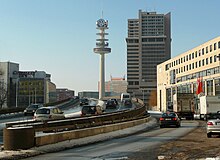Development community Hannover
The construction community Hanover was an association of landowners , merchants and entrepreneurs founded in Hanover after the air raids on Hanover and the Second World War in cooperation with the city for the purpose of rapid reconstruction .
history

The proposal for the establishment of the joint venture came on December 1, 1948 from the Hanoverian Lord Mayor Gustav Bratke and the city planner Rudolf Hillebrecht . Following the example of the Bremen development community in Hanover, a total of 125 Hanoverian citizens decided on January 27, 1949 to found the development community. Friedrich Meier-Greve (1899–1986), director of the Lower Saxony city council founded in 1918, took over the chairmanship . Representatives of the trade unions and professional organizations also sat on the advisory board of the construction community . One of the founding members was Herbert Röhrig , who later took over the chairmanship of the interest group, which was organized as a registered association .
With the support of Rudolf Hillebrecht and under the direction of the architect Konstanty Gutschow , the development of drafts down to the last detail for a planned and orderly reconstruction of the city was carried out on a voluntary basis . This earned those involved in the construction community the nickname “block architects”.
The construction community was a forum for suggestions, suggestions for changes and criticism for the City Council of Hanover . Rudolf Hillebrecht's particular achievements here consisted in convincing property owners of the necessity of new property boundaries and assigning them to the cession of their private areas for public use, e.g. for future- oriented road or footpath construction .
The "First Memorandum " on the inner city of September 1949 of the construction community formed the basis for the following construction decisions by the City Council of Hanover and for an inner-city land use plan from 1950.
A second memorandum of the building administration in connection with the zoning plan, which was created in close cooperation with the development community, took into account a future-oriented growth of the city of Hanover to up to 600,000 people. Based on historical circumstances, social, transport and economic policy needs of the time were taken into account and presented as future-oriented by the specialist journal Die neue Stadt .
Also in 1950, at the suggestion of the Hanover construction community, the construction community around the Kreuzkirche was established , in which all property owners in the area actually joined and brought their properties into the community as shares. On June 30th of that year the foundation stone was laid for the Kreuzkirchenviertel, which has 234 apartments .
1951 could - even a view to increasing Oststadt - "in an exemplary cooperation between the construction community [Hannover] and the city administration ," the progress of the new Raschplatz - tangent are set as route between the Weidendamm / Vahrenwalder Straße and the Sallstraße in the southern part .
In 1953 it was possible to celebrate again with the construction community around the Kreuzkirche : the first cornerstone was laid for 77 additional apartments and 23 shops in Bonehauerstrasse .
The construction community Hannover in cooperation with the urban planner Rudolf Hillebrecht ensured - in comparison with other German cities - for an unusually fast, especially future-oriented reconstruction of the city and was jointly responsible for the recognition by the foreign press as the " miracle of Hannover ".
Other personalities
- Friedrich Buhmann (1882–1962), businessman, director of the (later) Dr. Buhmann school , builder in Hanover
Fonts
- First memorandum - Downtown , September 1949
- Aufbaugemeinschaft Hannover eV (Ed.): Hannover-Oststadt - "the Raschplatztangente ". Contributions to the construction planning of the capital Hanover , edited by Konstanty Gutschow, Hanover: Madsack , 1951 (51 pages, with illustrations and graphic representations )
See also
literature
- Axel Düker: Stadt- und Verkehrsplanungen between 1945 and 1955. In: Transport planning of German cities between 1920 and 1960, illustrated using the example of Hanover , at the same time master's thesis at the University of Hanover 2002, Hamburg: Diplomica-Verlag, 2008, ISBN 978-3-8366 -5737-2 , pp. 66-107; online through google books
- NN : URBAN CONSTRUCTION / HILLEBRECHT / The miracle of Hanover. In: Der Spiegel , edition 23/1959 of June 3, 1959, pp. 55-69; on-line
- Friedrich Lindau : Hanover. Reconstruction and destruction. The city in dealing with its architectural identity , with a preface by Paulhans Peters, 2nd, revised. Edition, Hanover: Schlüter , 2001, ISBN 3-87706-659-3 ; partly online via Google books
- Waldemar R. Röhrbein : Tackling and finishing. Hanover's reconstruction in the 1950s. A source reading book , in the series of writings of the Historisches Museum Hannover , Vol. 5, Hannover: Historisches Museum Hannover , 1993, ISBN 3-910073-06-9
- Thomas Schwark : Development Community Hanover. In: Klaus Mlynek, Waldemar R. Röhrbein (eds.) U. a .: City Lexicon Hanover . From the beginning to the present. Schlütersche, Hannover 2009, ISBN 978-3-89993-662-9 , p. 37.
Web links
- Literature by and about the construction community in the catalog of the German National Library
Individual evidence
- ↑ a b c d e f Thomas Schwark: Aufbaugemeinschaft Hannover (see literature)
- ↑ a b c d e f Waldemar R. Röhrbein: 1949. In: Hannover Chronik here: p. 223 u.ö .; online through google books
- ↑ Waldemar R. Röhrbein: RÖHRIG, Herbert. In: Dirk Böttcher , Klaus Mlynek, Waldemar R. Röhrbein, Hugo Thielen: Hannoversches Biographisches Lexikon . From the beginning to the present. Schlütersche, Hannover 2002, ISBN 3-87706-706-9 , p. 298f.
- ↑ Note: In the biography of Herbert Röhrig, the founding date can be read from 1945, but in the city encyclopedia of Hanover on the development community from 1949
- ↑ Compare the editorship of the data set DNB 997020687 at the German National Library
- ↑ NN: STÄDTEBAU / HILLEBRECHT / The miracle of Hanover (see literature)
- ^ Waldemar R. Röhrbein: Buhmann, Friedrich. In: Stadtlexikon Hannover , p. 96


